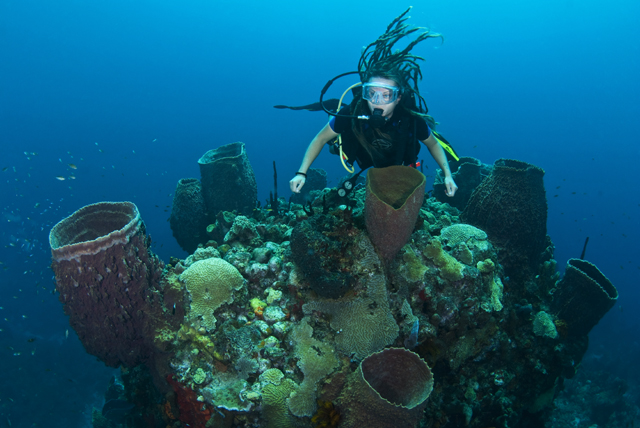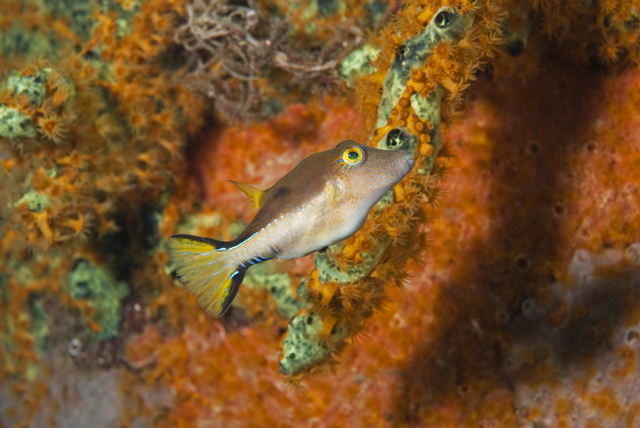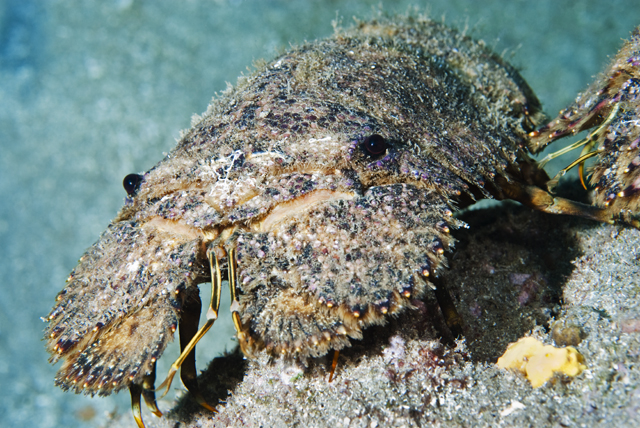News
Dominica’s Dive Fest
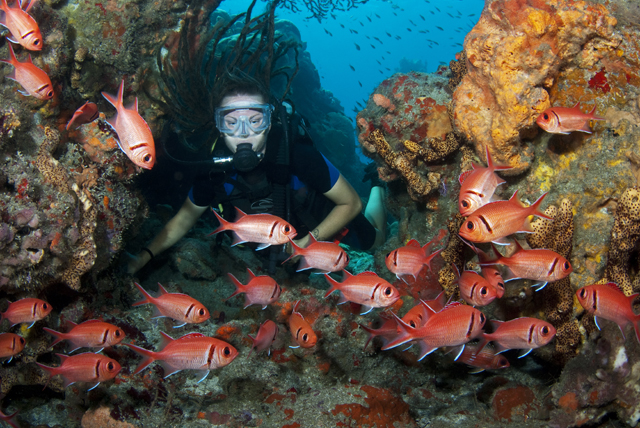
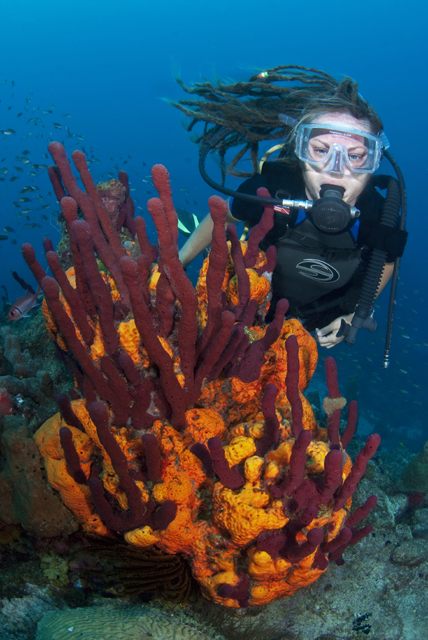 The Dominica Dive Fest has been steadily growing in size and stature since its humble beginnings back in 1984. I heard rumblings that this year’s event would be bigger and better than ever with street parties, lionfish cook outs, live bands, canoe races and other waterside activities. In my mind this had all the makings of a perfect holiday combination. Diving all day and partying all night! A 7-day break meant that I would miss the start of the 9-day event but still be around for the fish fry finale at Soufriere.
The Dominica Dive Fest has been steadily growing in size and stature since its humble beginnings back in 1984. I heard rumblings that this year’s event would be bigger and better than ever with street parties, lionfish cook outs, live bands, canoe races and other waterside activities. In my mind this had all the makings of a perfect holiday combination. Diving all day and partying all night! A 7-day break meant that I would miss the start of the 9-day event but still be around for the fish fry finale at Soufriere.
My overall plan was to check out the hotels and dive centres located along the south west (Caribbean) coast. This was also where most of the dive fest activities were being held. There are no direct flights to Dominica so I went as far as Antigua with BA and then used the local LIAT service. I found Oris, my taxi driver, waiting for me outside Melville Hall Airport situated at the north east end of the island. The transfer took about 1.5 hours door to door. As we drove along the winding roads I realised this was definitely one of the greenest Caribbean islands I had ever visited. Reading between the lines this probably meant there would be a patch of rain or two heading my way. Just to confirm my thoughts Oris told me there were more than three hundred rivers and streams (I was worried that run-off might affect the underwater visibility but it didn’t make any difference). Trafalgar falls is well worth a visit on a non-diving day. Further downstream the water has been re-routed into a hydro electric station. This supplies a reasonable percentage of the islands power requirements.
The 3.5-star Anchorage Hotel was my first port of call. This is pretty much an out an out divers’ resort. There are thirty two rooms in all. Most of the rooms are a nice size with separate bathrooms and balconies overlooking the sea. The full breakfast was called an ‘English Air Tank’ which made me feel right at home. The skeletal remains of a juvenile sperm whale are on display inside the hotel. Yvonne Armour, the managing director, said that it was used for whale educational trips. Whale watching was a popular tourist attraction. During peak season (November to April) they run two or three trips a week. Andrew Armour, also known as the ‘whale whisperer’, said there was an 85% chance of actually sighting whales, dolphins and orcas. For the past 12 years Andrew has encountered the same sperm whale, named Scar. This particular whale allows him to come within touching distance.
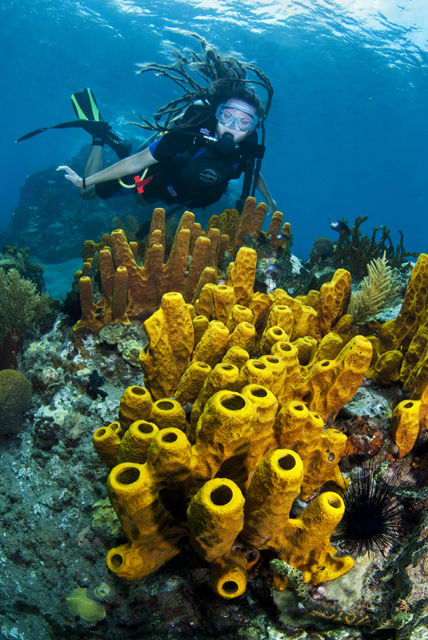 The on-site dive centre managed by Michael Henry is open all year round. Michael said he regularly dives sixteen sites inside the Scott’s Head marine reserve. He offers a two tank morning dive from 9am until around 1pm followed by a single tank afternoon dive (only for groups). Boat journey times are no more than 20 minutes each way. Shore diving is free of charge for anyone that books a dive package. The house reef is teaming with marine life. There are a number of old engine blocks sitting amongst the boulders on the shallow reef at 6-10m, then a field of dense sea grass followed by a deeper reef loaded with barrel sponges at 20-30m. I spent more than two hours exploring the site and found the best macro subject, a long nosed puffer fish, right next to the jetty steps where I jumped in.
The on-site dive centre managed by Michael Henry is open all year round. Michael said he regularly dives sixteen sites inside the Scott’s Head marine reserve. He offers a two tank morning dive from 9am until around 1pm followed by a single tank afternoon dive (only for groups). Boat journey times are no more than 20 minutes each way. Shore diving is free of charge for anyone that books a dive package. The house reef is teaming with marine life. There are a number of old engine blocks sitting amongst the boulders on the shallow reef at 6-10m, then a field of dense sea grass followed by a deeper reef loaded with barrel sponges at 20-30m. I spent more than two hours exploring the site and found the best macro subject, a long nosed puffer fish, right next to the jetty steps where I jumped in.
Although July is known as the low season there seemed to be plenty of dive groups about. I managed to choose two of the quieter days with Anchorage dive centre. Michael’s favourite site is called swiss cheese. He said “you have everything in one dive. Pinnacles, drop offs and a big variety of animal life”. Michael had made arrangements for us to go out with Divemaster Alicia Stevens and Flibert the boat skipper. The site is located where the Caribbean meets the Atlantic. Michael had already warned me about strong currents so when I clocked sight of the mooring buoy being sucked underwater I had a fair idea what to expect. We were ducking behind rocks for cover and then finning like crazy across the more exposed areas. The swim throughs were crowded with black bar soldier fish and cave sweepers. I watched two scorpion fish chasing after each other then four slipper lobsters shuffled out into the open. We drifted back along a sheer wall bursting with purple gorgonians. A shoal of one hundred plus rainbow runners rounded off the spectacular show as we made our way back to the mooring line. This had turned out to be a real adrenalin dive. Michael said “I wouldn’t normally take anybody here in these conditions. This is for experienced divers only”. Andrew Armour said “this really is a wow dive. Every diver says wow afterwards”.
At nearly every dive site I saw turtles either at the surface or underwater. My only ‘intimate’ encounter happened at a site called dangle bends. A small hawksbill was flying towards Alicia but just as I put my finger on the shutter release button twenty divers appeared. I was just as startled as the turtle. The hawksbill bolted into the blue and I lucked out on a perfect photo opportunity. Dangle bends is littered with barrel sponges of all shapes and sizes. Sometimes I found a grouper or puffer fish hiding inside. On rare occasions there would be a lionfish lurking but Dominica has an extremely proactive ‘shoot to kill’ policy. The dive guides were even spearing them in front of the guests and cutting off the poisonous spines with scissors.
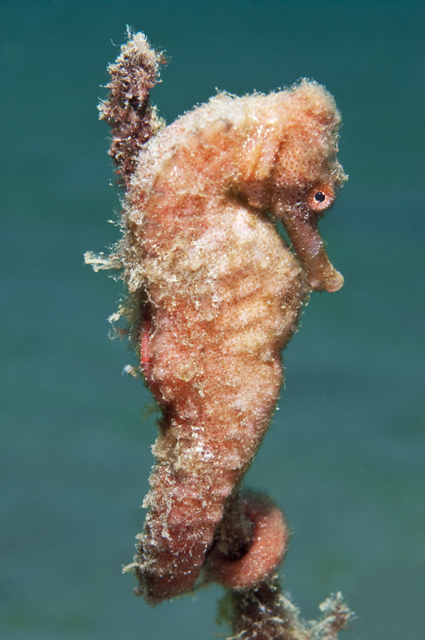 By now the Dive Fest evening activities were in full swing. The Anchorage Hotel hosted Dominica’s first ever ‘Iron Chef’ cooking competition hotly contested by five prominent chefs from different hotels and restaurants. The event was basically a Caribbean version of the popular masterchef television series. All the participants were given a stove, a bag of ingredients and 30 minutes of cooking time. They had to prepare a lionfish starter followed by a fish entree. A panel of judges tasted the food and selected a winner. Jessica Pinard-Byrne Yard won the coveted title with two delicious lionfish dishes. I tried lionfish fried in coconut batter and it tasted pretty good. Just to round off the evening Simon Walsh, the MD of Images Dominica, gave a talk about lionfish explaining the reasons behind the mass culling.
By now the Dive Fest evening activities were in full swing. The Anchorage Hotel hosted Dominica’s first ever ‘Iron Chef’ cooking competition hotly contested by five prominent chefs from different hotels and restaurants. The event was basically a Caribbean version of the popular masterchef television series. All the participants were given a stove, a bag of ingredients and 30 minutes of cooking time. They had to prepare a lionfish starter followed by a fish entree. A panel of judges tasted the food and selected a winner. Jessica Pinard-Byrne Yard won the coveted title with two delicious lionfish dishes. I tried lionfish fried in coconut batter and it tasted pretty good. Just to round off the evening Simon Walsh, the MD of Images Dominica, gave a talk about lionfish explaining the reasons behind the mass culling.
Dive Dominica happened to be right next door to the Anchorage Hotel. I spoke with Daniel Perryman, the dive centre manager. Daniel said Dive Dominica is the biggest dive centre on the island. His father Derek started diving in 1983 and opened the dive centre in 1988. The 3-star Castle Comfort Lodge is also part of the complex. There are fourteen rooms available, seven have ocean views. The whole set up is basically the same as the Anchorage Hotel with a house reef, two morning boat dives and one afternoon dive. Daniel said “Dominica is like an aquarium, it’s good for beginners”. Daniel’s favourite site is dangle bends. He said “there are colours, pinnacles and lots of life”. For the more experienced divers he recommended diving on the Atlantic side where there was a better chance of seeing bigger animals. Unfortunately I didn’t get the opportunity to see for myself as the dive boats stayed inside the marine reserve.
I joined a group of divers from REEF field surveys and set off for Champagne Reef. This is probably Dominica’s most talked about site due to the hot sulphur beds creating streams of bubbles. In places the seabed is too hot to touch. This didn’t seem to affect the marine life as close by I found eagle rays, sting rays and even seahorses. Sea urchins were thriving. I even managed to spear myself. At least I managed to pull out the spines in one piece so there was no infection. The next dive at coral garden was just as relaxing with plenty of tube sponges and soft corals on display.
At the half way stage I transferred over to the upmarket 4-star Fort Young Hotel located in the capital, Roseau. The seventy one room hotel had been built within the walls of an old colonial fort. Two of the old cannons sit outside the main entrance. I was given a huge room with sea view and balcony. To be honest the hotel was far too classy for the typical eat, sleep, dive brigade. The resident dive centre is run by Dive Dominica. This was mainly used as a booking office. Divers were picked up at the jetty and brought back to the main centre.
 As part of dive fest week Fort Young laid on a special ‘happy hour’ session followed by live music and a DJ. The local beer is called Kubuli and costs approx 6 Eastern Caribbean dollars a bottle (current rates are 2.6 EC to the US dollar). I really do recommend trying out the local specialty, chicken roti. They make perfect après dive snacks.
As part of dive fest week Fort Young laid on a special ‘happy hour’ session followed by live music and a DJ. The local beer is called Kubuli and costs approx 6 Eastern Caribbean dollars a bottle (current rates are 2.6 EC to the US dollar). I really do recommend trying out the local specialty, chicken roti. They make perfect après dive snacks.
Just to round off my trip I popped into Aldive owned by Billy Lawrence. In all there are seven dive centres dotted around the island. Three of which are located along a 1km stretch of beachfront. Billy had previously worked for Dive Dominica before opening his own centre in 2006. Aldive was a cosy set up with 5 staff and 2 boats. Billy showed me around the complex and introduced me to Cedric the lionfish looking all forlorn in a giant gold fish bowl. Cedric had survived the past few days but would probably end up in the frying pan sometime soon. While Billy was entertaining his Barbadian guests I snuck off for a night dive on the house reef. Less than one hundred metres from the jetty there is a line of boulders covered in soft corals and sponges at a depth of 6-8m. I found yellow tailed snapper, grouper, boxfish, puffers, crabs, trumpets and jacks all within a 100m area.
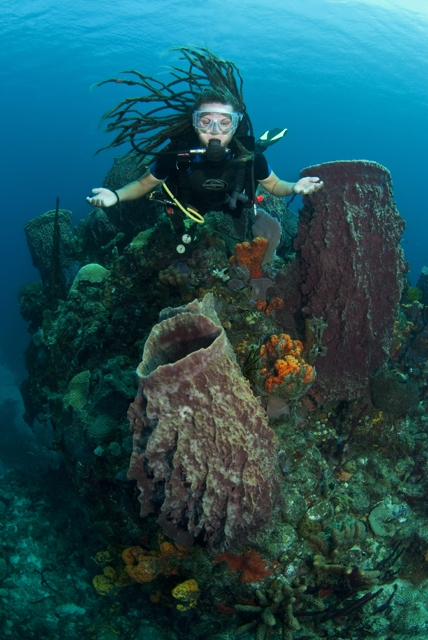 The Dive Fest celebrations came to a boozy climax at the Soufriere fish fry. Locals and tourists mingled together for a day and night of eating, drinking and partying. Somewhere along the way there was a canoe race across the bay and back. This was won by Dominica Coconut Products.
The Dive Fest celebrations came to a boozy climax at the Soufriere fish fry. Locals and tourists mingled together for a day and night of eating, drinking and partying. Somewhere along the way there was a canoe race across the bay and back. This was won by Dominica Coconut Products.
I only got to dive in the Scott’s Head Marine Reserve during my 7-day stay. I didn’t see any wrecks but there were plenty of walls and reefs to explore. Photographers are guaranteed plenty of macro critters with sporadic big fish encounters. Swiss cheese was definitely my favourite dive site. Michael from Anchorage dive centre said there was another full-on site called west wall (which is basically a continuation of swiss cheese) but the site has no permanent mooring buoy so he rarely took divers there. The Dive fest definitely spiced up my evening entertainment and judging by the turnout it was a resounding success. Next year’s event can only get better. On my last day I toured around the island checking out the botanical gardens (where a very civilised game of cricket was in full swing) followed by a trip to the sulphur spa. But with a name like Screw’s I wasn’t quite sure what to expect!
Dominica Dive Fest 2015 will be running from the 10th – 19th July. Keep up-to-date with the event by liking the Facebook page here.
Blogs
Northern Red Sea Reefs and Wrecks Trip Report, Part 3: The Mighty Thistlegorm

Jake Davies boards Ghazala Explorer for an unforgettable Red Sea diving experience…
Overnight, the wind picked up, making the planned morning dive a bit bumpy on the Zodiacs to the drop point on Thomas Reef. There, we would dive along the reef before descending through the canyon and then passing under the arch before ascending the wall with a gentle drift. The site provided great encounters with more pelagic species, including shoals of large barracuda, tuna, and bigeye trevally.
Once back on the boat, it was time to get everything tied down again as we would head back south. This time, with the wind behind us, heading to Ras Mohammed to dive Jackfish Alley for another great gentle drift wall dive before then heading up the coast towards the Gulf of Suez to moor up at the wreck of the Thistlegorm. This being the highlight wreck dive of the trip and for many onboard, including myself, it was the first time diving this iconic wreck. I had heard so much about the wreck from friends, and globally, this is a must on any diver’s list. Fortunately for us, there was only one other boat at the site, which was a rarity. A great briefing was delivered by Ahmed, who provided a detailed background about the wreck’s history along with all the required safety information as the currents and visibility at the site can be variable.

Kitting up, there was a lot of excitement on deck before entering the water and heading down the shoreline. Descending to the wreck, there was a light northerly current which reduced the visibility, making it feel more like the conditions that can be found off the Welsh coast. At 10m from the bottom, the outline of the wreck appeared as we reached the area of the wreck which had been bombed, as our mooring line was attached to part of the propeller shaft. Arriving on deck, instantly everywhere you looked there were many of the supplies which the ship was carrying, including Bren Carrier tanks and projectiles that instantly stood out.

We headed around the exterior, taking a look at the large propeller and guns mounted on deck before entering the wreck on the port side to take a look in the holds. It was incredible to see all the trucks, Norton 16H, and BSA motorcycles still perfectly stacked within, providing a real snapshot in time.

Overall, we had four dives on the Thistlegorm, where for all of the dives we were the only group in the water, and at times, there were just three of us on the whole wreck, which made it even more special, especially knowing that most days the wreck has hundreds of divers. Along with the history of the wreck, there was plenty of marine life on the wreck and around, from big green turtles to batfish, along with shoals of mackerel being hunted by trevally. Some unforgettable dives.

The final leg of the trip saw us cross back over the Suez Canal to the Gobal Islands where we planned to stay the night and do three dives at the Dolphin House for the potential of sharing the dive with dolphins. The site, which included a channel that was teeming with reef fish, especially large numbers of goatfish that swam in large shoals along the edge of the reef. These were nice relaxing dives to end the week. Unfortunately, the dolphins didn’t show up, which was okay as like all marine life they are difficult to predict and you can’t guarantee what’s going to be seen. With the last dive complete, we headed back to port for the final night where it was time to clean all the kit and pack before the departure flight the next day.

The whole week from start to finish on Ghazala Explorer was amazing; the boat had all the facilities you need for a comfortable week aboard. The crew were always there to help throughout the day and the chefs providing top quality food which was required after every dive. The itinerary providing some of the best diving with a nice mixture of wreck and reef dives. I would recommend the trip to anyone, whether it’s your first Red Sea liveaboard in the Red Sea or you’re revisiting. Hopefully, it’s not too long before I head back to explore more of the Red Sea onboard Ghazala Explorer.

To find out more about the Northern Red Sea reef and wrecks itineraries aboard Ghazala Explorer, or to book, contact Scuba Travel now:
Email: dive@scubatravel.com
Tel: +44 (0)1483 411590
Photos: Jake Davies / Avalon.Red
Blogs
Northern Red Sea Reefs and Wrecks Trip Report, Part 2: Wall to Wall Wrecks

Jake Davies boards Ghazala Explorer for an unforgettable Red Sea diving experience…
The second day’s diving was a day full of wreck diving at Abu Nuhas, which included the Chrisoula K, Carnatic, and Ghiannis D. The first dive of the day was onto the Chrisoula K, also known as the wreck of tiles. The 98m vessel remains largely intact where she was loaded with tiles which can be seen throughout the hold. The stern sits at 26m and the bow just below the surface. One of the highlights of the wreck is heading inside and seeing the workroom where the machinery used for cutting the tiles are perfectly intact. The bow provided some relaxing scenery as the bright sunlight highlighted the colours of the soft coral reef and the many reef fish.

Following breakfast, we then headed to the next wreck, which was the Carnatic. The Carnatic is an 89.9m sail steamer vessel that was built in Britain back in 1862. She ran aground on the reef back in 1869 and remains at 27m. At the time, she was carrying a range of items, including 40,000 sterling in gold. An impressive wreck where much of the superstructure remains, and the two large masts lay on the seafloor. The wooden ribs of the hull provide structures for lots of soft corals, and into the stern section, the light beams through, bouncing off the large shoals of glass fish that can be found using the structure as shelter from the larger predators that are found outside of the wreck.

The final wreck at Abu Nuhas was the Ghiannis D, originally called ‘Shoyo Maru,’ which was 99.5m long and built in Japan back in 1969 before becoming a Greek-registered cargo ship in 1980. The ship then ran aground on the reef on April 19th, 1983, and now sits at the bottom at a depth of 27m. Heading down the line, the stern of the ship remains in good condition compared to the rest of the hull. The highlight of the wreck, though, is heading into the stern section and down the flights of stairs to enter the engine room, which remains in good condition and is definitely worth exploring. After exploring the interior section of the ship, we then headed over to see the rest of the superstructure, where it’s particularly interesting to see the large table corals that have grown at the bow relatively quickly considering the date the ship sank. After surfacing and enjoying some afternoon snacks, we made sure everything was strapped down and secured as we would be heading north and crossing the Gulf of Suez, where the winds were still creating plenty of chop.

The next morning, it was a short hop to Ras Mohammed Nature Reserve for the next couple of days of diving. The 6am wake-up call came along with the briefing for the first site we would be diving, which was Shark & Yolanda. The low current conditions allowed us to start the dive at Anemone City, where we would drift along the steep, coral-filled wall. These dives involved drifts, as mooring in Ras Mohammed wasn’t allowed to protect the reefs. As a dive site, Shark & Yolanda is well-known and historically had a lot of sharks, but unfortunately not so many in recent years, especially not so early in the season. However, there was always a chance when looking out into the blue.

The gentle drift took us along the steep walls of the site, with plenty of anemone fish to be seen and a huge variety of corals. It wasn’t long into the dive before we were accompanied by a hawksbill turtle, who drifted with us between the two atolls before parting ways. Between the two reefs, the shallow patch with parts of coral heads surrounded by sand provided the chance to see a few blue-spotted stingrays that were mainly resting underneath the corals and are always a pleasure to see. With this being the morning dive, the early sunlight lit up the walls, providing tranquil moments. Looking out into the blue, there was very little to be seen, but a small shoal of batfish shimmering underneath the sunlight was a moment to capture as we watched them swim by as they watched us.

Towards the end of the dive, we stopped at the wreck of the Jolanda where the seafloor was scattered with toilets from the containers it was carrying. This provided a unique site to make a safety stop, which was also accompanied by a large barracuda slowly swimming by, along with a hawksbill turtle calmly swimming over the reef as the sun rays danced in the distance.
For the next dive, we headed north to the Strait of Tiran to explore the reefs situated between Tiran Island and Sharm El Sheik, which were named after the British divers who had found them. We started on Jackson before heading to Gordons Reef, where we also did the night dive. All the atolls at these sites provided stunning, bustling coral reefs close to the surface and steep walls to swim along, which always provided the opportunity to keep an eye out for some of the larger species that can be seen in the blue. Midwater around Jackson Reef was filled with red-toothed triggerfish and shoals of banner fish, which at times were so dense that you couldn’t see into the blue. Moments went by peacefully as we enjoyed the slow drift above the reef, watching these shoals swim around under the mid-afternoon sun.

The night dive at Gordon’s Reef was mainly among the stacks of corals surrounded by sand, which was great to explore under the darkness. After some time circling the corals, we came across what we were really hoping to find, and that was an octopus hunting on the reef. We spent the majority of the dive just watching it crawl among the reef, blending into its changing surroundings through changes in colour and skin texture. It’s always so fascinating and captivating to watch these incredibly intelligent animals, in awe of their ability to carry out these physical changes to perfectly blend into the reef. Before we knew it, it was time to head back to the boat to enjoy a well-deserved tasty dinner prepared by the talented chefs onboard.
Check in for the 3rd and final part of this series from Jake tomorrow!
To find out more about the Northern Red Sea reef and wrecks itineraries aboard Ghazala Explorer, or to book, contact Scuba Travel now:
Email: dive@scubatravel.com
Tel: +44 (0)1483 411590
Photos: Jake Davies / Avalon.Red
-

 News3 months ago
News3 months agoHone your underwater photography skills with Alphamarine Photography at Red Sea Diving Safari in March
-

 News3 months ago
News3 months agoCapturing Critters in Lembeh Underwater Photography Workshop 2024: Event Roundup
-

 Marine Life & Conservation Blogs2 months ago
Marine Life & Conservation Blogs2 months agoCreature Feature: Swell Sharks
-

 Blogs2 months ago
Blogs2 months agoMurex Resorts: Passport to Paradise!
-

 Blogs2 months ago
Blogs2 months agoDiver Discovering Whale Skeletons Beneath Ice Judged World’s Best Underwater Photograph
-

 Gear Reviews3 months ago
Gear Reviews3 months agoGear Review: Oceanic+ Dive Housing for iPhone
-

 Marine Life & Conservation2 months ago
Marine Life & Conservation2 months agoSave the Manatee Club launches brand new webcams at Silver Springs State Park, Florida
-

 News3 months ago
News3 months agoWorld’s Best Underwater Photographers Unveil Breathtaking Images at World Shootout 2023


